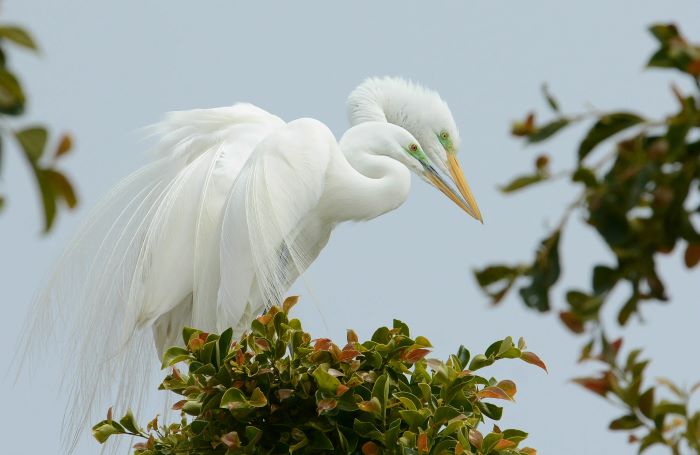With its bright white plumage and imposing stature, the great egret makes a dramatic statement wherever it alights. Yet barely a century ago, this elegant waterbird teetered at the brink of extinction in North America due to demand for its decorative feathers. Fortunately, conservation efforts allowed great egrets to rebound strongly. But despite a population resurgence, great egrets still face threats that justify ongoing protected status concern.

Great Egret Natural History
Great egrets belong to the Ardeidae family of long-necked, long-legged herons and egrets. They breed in colonies mostly across the eastern and southern United States, clustering nests high in waterside trees. Their plumage adapts seasonally, donning delicate ornamental feathers for mating before sporting more subdued practical attire. Great egrets hunt solo by patiently stalking fish, frogs, and other aquatic fare at the water’s edge. In the late 1800s, great egret numbers dwindled dangerously from hunting and egg harvesting to supply the fashion industry. Conservation actions prevented their eradication but populations are a fraction of pre-exploitation abundance.
Conservation Status Definitions and Criteria
The International Union for Conservation of Nature (IUCN) manages global standards for quantifying extinction risk levels in animal species:
• Least Concern – Species with hearty, self-sustaining populations not needing intervention.
• Near Threatened – Species currently stable but facing concerning declines ongoing or imminent.
• Vulnerable – Species experiencing rapid declines from threats needing conservation action.
• Endangered – Species severely threatened with high extinction risk from rapid ongoing population declines.
• Critically Endangered – Species facing imminent population collapses with extreme extinction risk if threats continue.
These categories provide benchmarks for gauging the great egret’s current population trajectory. Formal “endangered” or “threatened” designations also convey legal protections in many regions.
The Great Egret’s Conservation Comeback Story
In North America, great egrets nearly vanished by around 1895 with as few as 20 known breeding pairs, making them endangered. However, public awareness campaigns helped spark early wildlife conservation victories. In the early 1900s, great egret numbers recovered substantially thanks to new laws prohibiting plume hunting paired with fledgling protected coastal reserves.
Great egrets surpassed several thousand breeding pairs across the southeastern USA by the 1950s. Their population grew exponentially through the 1970s, bolstered by dichlorodiphenyltrichloroethane (DDT) bans and expanding wetland protections. Estimates now place North American great egret numbers at over 150,000 birds. Their revival merits a glowing “Least Concern” conservation success ranking.
Yet Beyond Least Concern Qualifiers
Does robust population growth mean great egrets no longer warrant extra vigilance? Though not currently endangered or threatened, great egrets still meet several Near Threatened criteria:
• They inhabit relatively few isolated wetlands in restricted ranges.
• Small, fluctuating populations remain in certain regions like California.
• Breeding habitat threats continue from pollution, habitat loss and disruption by human recreation.
• Climate change presents new extreme weather threats to breeding cycles.
• Preserving genetic diversity across scattered subpopulations poses long term challenges.
These qualifiers suggest preventative conservation measures remain prudent to enable great egret population stability despite overall abundance. Least concern status does not equate to complacency about emerging risks to their recovery.
Great Egret Status Elsewhere Globally
Like North American great egrets, those in Europe suffered extreme plume overhunting. But conservation in the early 1900s allowed them to repopulate readily as suitable habitat remained abundant. Elsewhere like Asia and Africa, great egrets seem mostly resilient and circuits remain strong near wetlands. This bolsters the species’ global status.
However, great egrets face escalating habitat loss in developing countries and climate change menaces their specialized breeding cycle nearly everywhere. Ongoing monitoring with updated regional threat assessments is crucial despite robust global numbers for now. Even least concern species deserve vigilant tracking and conservation readiness.
The Way Forward for Great Egrets
The great egret’s revival over the past century shows that even critically endangered species can return given prompt protective actions. It also demonstrates the importance of sustained conservation engagement to address new obstacles as conditions change over time. Though no longer actively imperiled, great egrets benefit from continued habitat protections, breeding disturbance reduction efforts and threat monitoring despite their current abundance.
Great egret resurgence stands as an avian conservation success symbolizing that hope remains even for the most besieged wildlife given appropriately marshalled resources and habitat protections. It also serves as a call for ongoing collaborative conservation commitment across borders to shepherd all species facing intensifying climate change and development pressures in the centuries ahead. With such efforts, the great egret’s beauty and environmental contributions will continue enriching wetland ecosystems for generations to come.
If you enjoyed this article, you might also read this: The Ultimate Guide to Raising Chickens in Your Backyard Like a Pro

Stina is the expert behind BirdFacts.net, dedicated to sharing her passion and knowledge about birds. With a degree in Environmental Science and over 6 years of birdwatching experience, she brings both expertise and enthusiasm to her writing. Stina’s work aims to inspire appreciation for birds and promote responsible birdwatching. Follow her bird-filled journey on Instagram.




